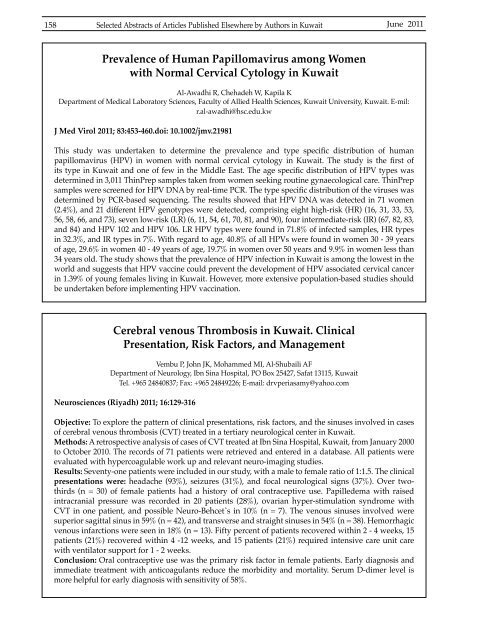Vol 43 # 2 June 2011 - Kma.org.kw
Vol 43 # 2 June 2011 - Kma.org.kw
Vol 43 # 2 June 2011 - Kma.org.kw
You also want an ePaper? Increase the reach of your titles
YUMPU automatically turns print PDFs into web optimized ePapers that Google loves.
158<br />
Selected Abstracts of Articles Published Elsewhere by Authors in Kuwait <strong>June</strong> <strong>2011</strong><br />
Prevalence of Human Papillomavirus among Women<br />
with Normal Cervical Cytology in Kuwait<br />
Al-Awadhi R, Chehadeh W, Kapila K<br />
Department of Medical Laboratory Sciences, Faculty of Allied Health Sciences, Kuwait University, Kuwait. E-mil:<br />
r.al-awadhi@hsc.edu.<strong>kw</strong><br />
J Med Virol <strong>2011</strong>; 83:453-460.doi: 10.1002/jmv.21981<br />
This study was undertaken to determine the prevalence and type specific distribution of human<br />
papillomavirus (HPV) in women with normal cervical cytology in Kuwait. The study is the first of<br />
its type in Kuwait and one of few in the Middle East. The age specific distribution of HPV types was<br />
determined in 3,011 ThinPrep samples taken from women seeking routine gynaecological care. ThinPrep<br />
samples were screened for HPV DNA by real-time PCR. The type specific distribution of the viruses was<br />
determined by PCR-based sequencing. The results showed that HPV DNA was detected in 71 women<br />
(2.4%), and 21 different HPV genotypes were detected, comprising eight high-risk (HR) (16, 31, 33, 53,<br />
56, 58, 66, and 73), seven low-risk (LR) (6, 11, 54, 61, 70, 81, and 90), four intermediate-risk (IR) (67, 82, 83,<br />
and 84) and HPV 102 and HPV 106. LR HPV types were found in 71.8% of infected samples, HR types<br />
in 32.3%, and IR types in 7%. With regard to age, 40.8% of all HPVs were found in women 30 - 39 years<br />
of age, 29.6% in women 40 - 49 years of age, 19.7% in women over 50 years and 9.9% in women less than<br />
34 years old. The study shows that the prevalence of HPV infection in Kuwait is among the lowest in the<br />
world and suggests that HPV vaccine could prevent the development of HPV associated cervical cancer<br />
in 1.39% of young females living in Kuwait. However, more extensive population-based studies should<br />
be undertaken before implementing HPV vaccination.<br />
Cerebral venous Thrombosis in Kuwait. Clinical<br />
Presentation, Risk Factors, and Management<br />
Vembu P, John JK, Mohammed MI, Al-Shubaili AF<br />
Department of Neurology, Ibn Sina Hospital, PO Box 25427, Safat 13115, Kuwait<br />
Tel. +965 24840837; Fax: +965 24849226; E-mail: drvperiasamy@yahoo.com<br />
Neurosciences (Riyadh) <strong>2011</strong>; 16:129-316<br />
Objective: To explore the pattern of clinical presentations, risk factors, and the sinuses involved in cases<br />
of cerebral venous thrombosis (CVT) treated in a tertiary neurological center in Kuwait.<br />
Methods: A retrospective analysis of cases of CVT treated at Ibn Sina Hospital, Kuwait, from January 2000<br />
to October 2010. The records of 71 patients were retrieved and entered in a database. All patients were<br />
evaluated with hypercoagulable work up and relevant neuro-imaging studies.<br />
Results: Seventy-one patients were included in our study, with a male to female ratio of 1:1.5. The clinical<br />
presentations were: headache (93%), seizures (31%), and focal neurological signs (37%). Over twothirds<br />
(n = 30) of female patients had a history of oral contraceptive use. Papilledema with raised<br />
intracranial pressure was recorded in 20 patients (28%), ovarian hyper-stimulation syndrome with<br />
CVT in one patient, and possible Neuro-Behcet`s in 10% (n = 7). The venous sinuses involved were<br />
superior sagittal sinus in 59% (n = 42), and transverse and straight sinuses in 54% (n = 38). Hemorrhagic<br />
venous infarctions were seen in 18% (n = 13). Fifty percent of patients recovered within 2 - 4 weeks, 15<br />
patients (21%) recovered within 4 -12 weeks, and 15 patients (21%) required intensive care unit care<br />
with ventilator support for 1 - 2 weeks.<br />
Conclusion: Oral contraceptive use was the primary risk factor in female patients. Early diagnosis and<br />
immediate treatment with anticoagulants reduce the morbidity and mortality. Serum D-dimer level is<br />
more helpful for early diagnosis with sensitivity of 58%.
















